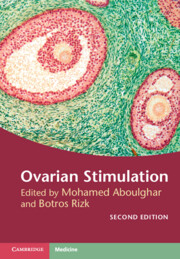Book contents
- Ovarian Stimulation
- Ovarian Stimulation
- Copyright page
- Dedication
- Contents
- Contributors
- About the Editors
- Foreword
- Preface to the first edition
- Preface to the second edition
- Section 1 Mild Forms of Ovarian Stimulation
- Section 2 Ovarian Hyperstimulation for IVF
- Section 3 Difficulties and Complications of Ovarian Stimulation and Implantation
- Chapter 12 Ovarian Stimulation in Difficult IVF Cases
- Chapter 13 Polycystic Ovary Syndrome: Ovulation Induction Strategies
- Chapter 14 Polycystic Ovary Syndrome: Controlled Ovarian Stimulation
- Chapter 15 Prevention of Ovarian Hyperstimulation Syndrome
- Chapter 16 Treatment of Ovarian Hyperstimulation Syndrome
- Chapter 17 How to Individualize Ovarian Stimulation Protocols to Avoid Difficulties and Complications
- Chapter 18 Endometrial Receptivity
- Chapter 19 Folliculogenesis and Implantation Failure
- Section 4 Non-conventional Forms Used during Ovarian Stimulation
- Section 5 Alternatives to Ovarian Hyperstimulation and Delayed Transfer
- Section 6 Procedures before, during, and after Ovarian Stimulation
- Index
- References
Chapter 12 - Ovarian Stimulation in Difficult IVF Cases
from Section 3 - Difficulties and Complications of Ovarian Stimulation and Implantation
Published online by Cambridge University Press: 14 April 2022
- Ovarian Stimulation
- Ovarian Stimulation
- Copyright page
- Dedication
- Contents
- Contributors
- About the Editors
- Foreword
- Preface to the first edition
- Preface to the second edition
- Section 1 Mild Forms of Ovarian Stimulation
- Section 2 Ovarian Hyperstimulation for IVF
- Section 3 Difficulties and Complications of Ovarian Stimulation and Implantation
- Chapter 12 Ovarian Stimulation in Difficult IVF Cases
- Chapter 13 Polycystic Ovary Syndrome: Ovulation Induction Strategies
- Chapter 14 Polycystic Ovary Syndrome: Controlled Ovarian Stimulation
- Chapter 15 Prevention of Ovarian Hyperstimulation Syndrome
- Chapter 16 Treatment of Ovarian Hyperstimulation Syndrome
- Chapter 17 How to Individualize Ovarian Stimulation Protocols to Avoid Difficulties and Complications
- Chapter 18 Endometrial Receptivity
- Chapter 19 Folliculogenesis and Implantation Failure
- Section 4 Non-conventional Forms Used during Ovarian Stimulation
- Section 5 Alternatives to Ovarian Hyperstimulation and Delayed Transfer
- Section 6 Procedures before, during, and after Ovarian Stimulation
- Index
- References
Summary
Poor ovarian responders (PORs) are the most challenging patients in assisted reproductive technology (ART) and account for 9 to 24 percent of in vitro fertilization (IVF) patients [1]. The difficulties to classify these patients are due to the lack of clear definition, 47 randomized controlled trials (RCTs) and 41 different definitions were reported [2].
- Type
- Chapter
- Information
- Ovarian Stimulation , pp. 109 - 118Publisher: Cambridge University PressPrint publication year: 2022



